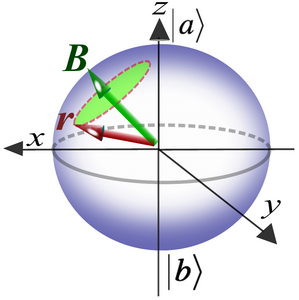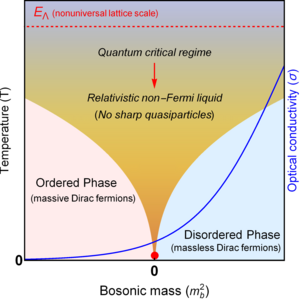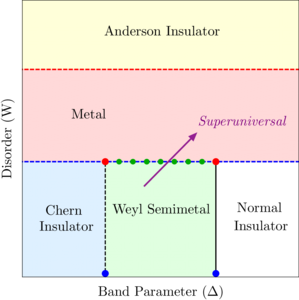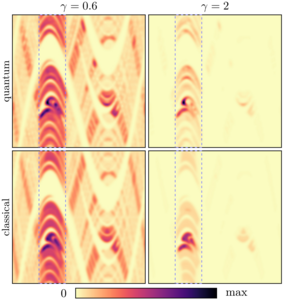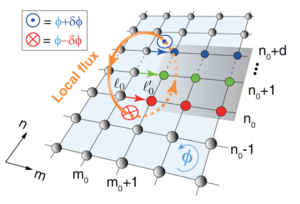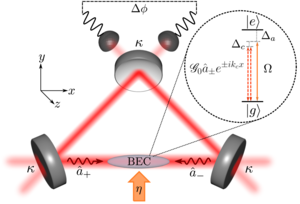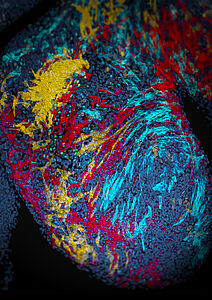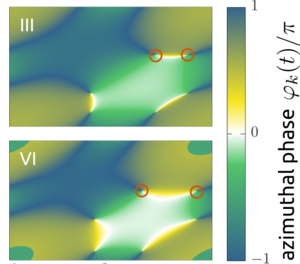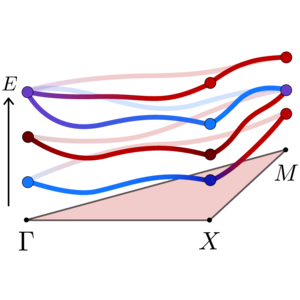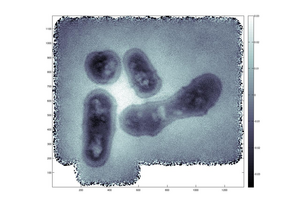Highlights
Publication Highlights
Measuring the single-particle density matrix in an optical lattice
L. A. Peña Ardila et al., Phys. Rev. Lett. 121, 260401 (2018)
Ultracold atoms in optical lattices provide clean, tunable, and well-isolated realizations of paradigmatic quantum lattice models. With the recent advent of quantum-gas microscopes, they now also offer the possibility to measure the occupations of individual lattice sites. What, however, has not yet been achieved is to measure those elements of the single-particle density matrix, which are off-diagonal in the occupation basis. Here, we propose a scheme to access these basic quantities both for fermions as well as hard-core bosons and investigate its accuracy and feasibility.
weiterlesenUltracold atoms in optical lattices provide clean, tunable, and well-isolated realizations of paradigmatic quantum lattice models. With the recent advent of quantum-gas microscopes, they now also offer the possibility to measure the occupations of individual lattice sites. What, however, has not yet been achieved is to measure those elements of the single-particle density matrix, which are off-diagonal in the occupation basis. Here, we propose a scheme to access these basic quantities both for fermions as well as hard-core bosons and investigate its accuracy and feasibility.
Publication Highlights
Collisionless Transport Close to a Fermionic Quantum Critical Point in Dirac Materials
B. Roy et al., Phys. Rev. Lett. 121, 137601 (2018)
Dirac fermions are realized as low-energy excitations in a wide class of condensed matter systems, such as graphene and surface states of topological insulators. These so-called Dirac materials are rather stable against weak Hubbard-like local interactions. However, at strong interactions they may undergo quantum phase transitions into broken symmetry phases, such as spin- and charge-density-waves. The question then arises what may be the possible experimental imprints of such a quantum phase transition in terms of observable. Researcher from MPIPKS in collaboration with Nordita recently showed that the frequency-dependent electrical conductivity at both zero and finite temperature gets suppressed in the close vicinity to such critical point in comparison to its counterpart in a noninteracting system. Such peculiar, but universal behavior stems from strong interactions among wildly fluctuating gapless fermionic and bosonic order-parameter excitations inside the quantum critical regime, occupied by a relativistic non-Fermi liquid.
weiterlesenDirac fermions are realized as low-energy excitations in a wide class of condensed matter systems, such as graphene and surface states of topological insulators. These so-called Dirac materials are rather stable against weak Hubbard-like local interactions. However, at strong interactions they may undergo quantum phase transitions into broken symmetry phases, such as spin- and charge-density-waves. The question then arises what may be the possible experimental imprints of such a quantum phase transition in terms of observable. Researcher from MPIPKS in collaboration with Nordita recently showed that the frequency-dependent electrical conductivity at both zero and finite temperature gets suppressed in the close vicinity to such critical point in comparison to its counterpart in a noninteracting system. Such peculiar, but universal behavior stems from strong interactions among wildly fluctuating gapless fermionic and bosonic order-parameter excitations inside the quantum critical regime, occupied by a relativistic non-Fermi liquid.
Publication Highlights
Global Phase Diagram of a Dirty Weyl Liquid and Emergent Superuniversality
B. Roy et al., Phys. Rev. X 8, 031076 (2018)
Weyl semimetals are exotic materials in which electrons behave more like photons - massless particles moving at a relativistic speed. However, it is unclear how well Weyl semimetals hold on to their bizarre properties in real disordered materials that are littered with impurities. Researchers from MPIPKS in collaboration with Nordita show that for small amounts of disorder such gapless topological semiconductors are stable, but at intermediate disorder these systems can undergo a quantum phase transition into a metallic phase, where electrons cease to behave as relativistic particles. Intriguingly, they discovered that the nature of this continuous transition is insensitive to the many (if not all) details of impurities, a phenomenon commonly referred to as superuniversality, which leaves its signature on the behavior of various observables, such as specific heat and electrical conductivity. These features combined with several other known transitions constitute the global phase diagram of disordered Weyl systems.
weiterlesenWeyl semimetals are exotic materials in which electrons behave more like photons - massless particles moving at a relativistic speed. However, it is unclear how well Weyl semimetals hold on to their bizarre properties in real disordered materials that are littered with impurities. Researchers from MPIPKS in collaboration with Nordita show that for small amounts of disorder such gapless topological semiconductors are stable, but at intermediate disorder these systems can undergo a quantum phase transition into a metallic phase, where electrons cease to behave as relativistic particles. Intriguingly, they discovered that the nature of this continuous transition is insensitive to the many (if not all) details of impurities, a phenomenon commonly referred to as superuniversality, which leaves its signature on the behavior of various observables, such as specific heat and electrical conductivity. These features combined with several other known transitions constitute the global phase diagram of disordered Weyl systems.
Publication Highlights
Resonance eigenfunction hypothesis for chaotic systems
K. Clauß et al., Phys. Rev. Lett. 121, 074101 (2018)
Classical systems with particles escaping through an opening are quantum mechanically described by resonance eigenfunctions. They are for example important for scattering experiments, like emission from optical microcavities, and show fractal patterns which strongly depend on their decay rate. The resonance eigenfunction hypothesis put forward in the paper provides a detailed understanding of this fractal structure. It is based on classical properties of the chaotic dynamics with a new time scale given by the temporal distance to the so-called chaotic saddle. Numerical support is presented for a chaotic map with escape.
weiterlesenClassical systems with particles escaping through an opening are quantum mechanically described by resonance eigenfunctions. They are for example important for scattering experiments, like emission from optical microcavities, and show fractal patterns which strongly depend on their decay rate. The resonance eigenfunction hypothesis put forward in the paper provides a detailed understanding of this fractal structure. It is based on classical properties of the chaotic dynamics with a new time scale given by the temporal distance to the so-called chaotic saddle. Numerical support is presented for a chaotic map with escape.
Publication Highlights
Floquet Engineering of Optical Solenoids and Quantized Charge Pumping along Tailored Paths in Two-Dimensional Chern Insulators
Botao Wang et al., Phys. Rev. Lett. 120, 243602 (2018)
The adiabatic creation of single quasipartices or quasiholes via the insertion of one magnetic flux quantum through an infinitely thin solenoid is a famous gedanken experiment of quantum-Hall physics. In the present paper, physicists from Dresden show how this scenario can be realized in a real experiment with ultracold atoms in optical lattices. For this purpose, they propose a scheme for engineering "optical solenoids", tunable artificial magnetic fields piercing a single plaquette of an optical lattice. Moreover, they investigate how this technique can be used for quantized charge pumping along tailored paths in two dimensional topological Chern insulators.
weiterlesenThe adiabatic creation of single quasipartices or quasiholes via the insertion of one magnetic flux quantum through an infinitely thin solenoid is a famous gedanken experiment of quantum-Hall physics. In the present paper, physicists from Dresden show how this scenario can be realized in a real experiment with ultracold atoms in optical lattices. For this purpose, they propose a scheme for engineering "optical solenoids", tunable artificial magnetic fields piercing a single plaquette of an optical lattice. Moreover, they investigate how this technique can be used for quantized charge pumping along tailored paths in two dimensional topological Chern insulators.
Publication Highlights
Driven-Dissipative Supersolid in a Ring Cavity
F. Mivehvar et al., Phys. Rev. Lett. 120, 123601 (2018)
Supersolids, a mysterious phase of matter consisting of a crystal which can flow without friction, have been elusive to experimental confirmation till last year, where the first realisations using ultracold atomic systems have been achieved. These atomic implementations however take place in driven-dissipative systems, a situation which lies outside the?thermal equilibrium scenario so far considered in theory.
In this work, we study for the first time the effect of the openness of the system on the main features of a supersolid, and find that its hallmarks can be robust against drive and dissipation whenever the latter preserve spatial translation invariance.
weiterlesenSupersolids, a mysterious phase of matter consisting of a crystal which can flow without friction, have been elusive to experimental confirmation till last year, where the first realisations using ultracold atomic systems have been achieved. These atomic implementations however take place in driven-dissipative systems, a situation which lies outside the?thermal equilibrium scenario so far considered in theory.
In this work, we study for the first time the effect of the openness of the system on the main features of a supersolid, and find that its hallmarks can be robust against drive and dissipation whenever the latter preserve spatial translation invariance.
Publication Highlights
Universality of clone dynamics during tissue development
S. Rulands et al., Nature Physics (2018)
The development of an organism relies on the tightly orchestrated behavior of many cells. How do these cells self-organize in order to build complex structures like the heart or the brain? To achieve this the fate of these cells must be precisely regulated and understanding the mechanisms of cell fate regulation is key for treating diseases that occur upon dysregulation, such as cancer or diabetes. The fate behaviour of stem and progenitor cells is reflected in the time evolution of their progeny, termed clones, which serve as a key experimental observable. But what can we actually learn from such clones about the processes that regulate their fate during development? Drawing on the results of genetic tracing studies, we show that, despite the complexity of organ development, clonal dynamics may converge to a critical state characterized by universal scaling behaviour of clone sizes. We show how this identification of universal scaling dependences may allow lineage-specific information to be distilled from experiments. Our study shows the emergence of core concepts of statistical physics in an unexpected context, identifying cellular systems as a laboratory to study non-equilibrium statistical physics.
weiterlesenThe development of an organism relies on the tightly orchestrated behavior of many cells. How do these cells self-organize in order to build complex structures like the heart or the brain? To achieve this the fate of these cells must be precisely regulated and understanding the mechanisms of cell fate regulation is key for treating diseases that occur upon dysregulation, such as cancer or diabetes. The fate behaviour of stem and progenitor cells is reflected in the time evolution of their progeny, termed clones, which serve as a key experimental observable. But what can we actually learn from such clones about the processes that regulate their fate during development? Drawing on the results of genetic tracing studies, we show that, despite the complexity of organ development, clonal dynamics may converge to a critical state characterized by universal scaling behaviour of clone sizes. We show how this identification of universal scaling dependences may allow lineage-specific information to be distilled from experiments. Our study shows the emergence of core concepts of statistical physics in an unexpected context, identifying cellular systems as a laboratory to study non-equilibrium statistical physics.
Publication Highlights
Dynamical quantum phase transitions: a review
M. Heyl, Rep. Prog. Phys. (2018)
Quantum theory provides an extensive framework for the description of the equilibrium properties of quantum matter. Yet experiments in quantum simulators have now opened up a route towards generating quantum states beyond this equilibrium paradigm. While these states promise to show properties not constrained by equilibrium principles such as the equal a priori probability of the microcanonical ensemble, identifying general properties of nonequilibrium quantum dynamics remains a major challenge especially in view of the lack of conventional concepts such as free energies. The theory of dynamical quantum phase transitions attempts to identify such general principles by lifting the concept of phase transitions to coherent quantum real-time evolution. This review provides a pedagogical introduction to this field. Starting from the general setting of nonequilibrium dynamics in closed quantum many-body systems, we give the definition of dynamical quantum phase transitions as phase transitions in time with physical quantities becoming nonanalytic at critical times. We summarize the achieved theoretical advances as well as the first experimental observations, and furthermore provide an outlook onto major open questions as well as future directions of research.
weiterlesenQuantum theory provides an extensive framework for the description of the equilibrium properties of quantum matter. Yet experiments in quantum simulators have now opened up a route towards generating quantum states beyond this equilibrium paradigm. While these states promise to show properties not constrained by equilibrium principles such as the equal a priori probability of the microcanonical ensemble, identifying general properties of nonequilibrium quantum dynamics remains a major challenge especially in view of the lack of conventional concepts such as free energies. The theory of dynamical quantum phase transitions attempts to identify such general principles by lifting the concept of phase transitions to coherent quantum real-time evolution. This review provides a pedagogical introduction to this field. Starting from the general setting of nonequilibrium dynamics in closed quantum many-body systems, we give the definition of dynamical quantum phase transitions as phase transitions in time with physical quantities becoming nonanalytic at critical times. We summarize the achieved theoretical advances as well as the first experimental observations, and furthermore provide an outlook onto major open questions as well as future directions of research.
Publication Highlights
Topological Classification of Crystalline Insulators through Band Structure Combinatorics
Jorrit Kruthoff et al., Phys. Rev. X 7, 041069
Topological insulators are exotic materials that are electrical insulators in their interior but can conduct electricity on their surface, and their discovery has fundamentally changed our understanding of how phases of matter may be organized. Most phases of matter are categorized by the symmetries that they break. Crystals break translational symmetry, magnets break rotational symmetry, and so on. Topological insulators, however, show that some phases can be distinct even though their symmetries are equal. Researchers have come up with a classification scheme--called the tenfold way--which allows for the categorization of topological phases depending on some general properties, such as whether or not they have time-reversal or particle-hole symmetry. We complement this categorization by providing a method for listing all possible topologically distinct phases of matter that do not have external symmetries but do have the types of internal (or lattice) symmetries that appear in the atomic arrangements of real solid materials. We explicitly list all possible phases in two-dimensional materials and provide an intuitive and easily applicable method for identifying the phases possible within a given lattice type in any dimension. Our method matches the known results based on the mathematically involved predictions of K-theory, which is known to be a rigorous way of identifying all possible topological phases. It thus provides insight into this mathematical arena based on a physical understanding of topological band structures. We also show how our method can be used to study the transitions between topological phases and predict whether they will result in topologically protected Weyl semimetals. This new classification can now be used to guide the search for new types of topological materials and related edge modes or exotic intermediate phases.
weiterlesenTopological insulators are exotic materials that are electrical insulators in their interior but can conduct electricity on their surface, and their discovery has fundamentally changed our understanding of how phases of matter may be organized. Most phases of matter are categorized by the symmetries that they break. Crystals break translational symmetry, magnets break rotational symmetry, and so on. Topological insulators, however, show that some phases can be distinct even though their symmetries are equal. Researchers have come up with a classification scheme--called the tenfold way--which allows for the categorization of topological phases depending on some general properties, such as whether or not they have time-reversal or particle-hole symmetry. We complement this categorization by providing a method for listing all possible topologically distinct phases of matter that do not have external symmetries but do have the types of internal (or lattice) symmetries that appear in the atomic arrangements of real solid materials. We explicitly list all possible phases in two-dimensional materials and provide an intuitive and easily applicable method for identifying the phases possible within a given lattice type in any dimension. Our method matches the known results based on the mathematically involved predictions of K-theory, which is known to be a rigorous way of identifying all possible topological phases. It thus provides insight into this mathematical arena based on a physical understanding of topological band structures. We also show how our method can be used to study the transitions between topological phases and predict whether they will result in topologically protected Weyl semimetals. This new classification can now be used to guide the search for new types of topological materials and related edge modes or exotic intermediate phases.
Publication Highlights
Live cell X-ray imaging of autophagic vacuoles formation and chromatin dynamics in fission yeast
Strelnikova et al., Scientific Reports 7, 13775 (2017)
The major challenge of X-ray imaging of living cellular specimens with a higher resolution than the optical resolution is the very low lethal radiation dose. Owing to the radiation damage and a low electron density contrast, sequential X-ray imaging of live cells was not possible so far. In our manuscript, we demonstrate the first X-ray movies of living yeast cells showing the dynamics of the autophagic vacuole formation and chromosome motion. It is a new way of seeing physiological processes of living organisms at nanoscale resolution. Moreover, the found lower lethal dose for dividing cells in comparison to non-dividing cells, might be an alternative approach to selective killing of malicious cells.
weiterlesenThe major challenge of X-ray imaging of living cellular specimens with a higher resolution than the optical resolution is the very low lethal radiation dose. Owing to the radiation damage and a low electron density contrast, sequential X-ray imaging of live cells was not possible so far. In our manuscript, we demonstrate the first X-ray movies of living yeast cells showing the dynamics of the autophagic vacuole formation and chromosome motion. It is a new way of seeing physiological processes of living organisms at nanoscale resolution. Moreover, the found lower lethal dose for dividing cells in comparison to non-dividing cells, might be an alternative approach to selective killing of malicious cells.


